- Home
- Jeanne Kalogridis
Lord of the Vampires
Lord of the Vampires Read online
PRAISE FOR
LORD OF THE VAMPIRES
AND
JEANNE KALOGRIDIS’S
VAMPIRE TRILOGY
“SUPERB … FRIGHTENING … AUTHENTICALLY ARRESTING.”
—The New York Times Book Review
“An original approach to the Dracula family chronicles.”
—People
“SEXY … THE BEST OF THIS EXCITING SERIES.”
—Midwest Book Review
“AN ENTERTAINING AND SUSPENSEFUL ADDITION TO THE VAMPIRE GENRE.”
—The Albuquerque Journal
“A SLY, LITERATE NARRATIVE AND LIPLICKING ACTION … [Lord of the Vampires] carries the action straight into Stoker with an overlapping plotline that cleaves closely to the famous original.”
—Kirkus Reviews
“KALOGRIDIS’S WRITING IS ELEGANT, TAUT, AND SENSUOUS.”
—New Woman
“Jeanne Kalogridis has launched a vampire hero who will haunt my nights for decades—or lifetimes—to come.”
—Jacqueline Lichtenberg, author, Those of My Blood
Dell books by Jeanne Kalogridis
LORD OF THE VAMPIRES
CHILDREN OF THE VAMPIRE
COVENANT WITH THE VAMPIRE
Published by
Dell Publishing
a division of
Random House, Inc.
Copyright © 1996 by Jeanne Kalogridis
All rights reserved. No part of this book may be reproduced or transmitted in any form or by any means, electronic or mechanical, including photocopying, recording, or by any information storage and retrieval system, without the written permission of the Publisher, except where permitted by law. For information address: Delacorte Press, New York, New York.
The trademark Dell® is registered in the U.S. Patent and Trademark Office.
eISBN: 978-0-307-80463-1
Reprinted by arrangment with Delacorte Press
v3.1
For my mother, Geraldine Marie Pulver
August 8, 1923-July 27, 1995
And sister, Nancy Ellen Dillard
September 23, 1952-February 1, 1994
ACKNOWLEDGMENTS
Heartfelt thanks are due the following august personages:
First and foremost, to Dell editor Jacob Hoye for his exceptional patience and kindness. The book you now hold in your hands arrived on his desk terribly late, and he, as well as copy editors and publicists, worked at an insane pace to get it onto the shelves. On behalf of him and all the other brave souls at Dell, I offer up humblest apologies, plus the offer to inflict upon myself thirty lashes with a cat-o’-nine-tails at the time and place of their choosing.
To Elizabeth Miller, Ph.D., one of the world’s premier Dracula experts and all-round nice person. Not only did she provide me with research materials and information about Mad Bad Vlad for the prologue, she also wrote the marvelous foreword included here.
To Sherry Gottlieb, fellow novelist, for her (and Bunny’s) friendship and her wonderfully wicked suggestion concerning the ending of this book. (Go out and buy Sherry’s fabulous police procedural with fangs, Love Bite, right now.)
To my brother, Kurt Rumler, for starting this whole damned vampire thing. You see, it was Kurt who, some twenty-eight years ago at the Mariner Hotel in St. Petersburg, shoved a paperback of Dracula into my hands and said: “Here, kid. Read this.…”
Absolutely to my agent, Russ Galen. My God, Russ, what would I do without you? (I mean, other than make a whole lot less money and have a lot more stress in my life.…)
And now, the best for last: To our beloved consort of eighteen years, with whom we are well pleased. George, I honestly could not have finished this book without your emotional and literary help. (Okay, so I steal your suggestions all the time—but, hey, I share the money, don’t I?) I love you madly—for your Grecian good looks, your intelligence, your twisted wit, your warmth, your charm, your generosity and delightful desire to spoil me—but mostly because no one else has ever made me feel so thoroughly loved.
—Jeanne Kalogridis
e-mail: [email protected]
web page: http://www.opa.com/vampire
Contents
Cover
Other Books by This Author
Title Page
Copyright
Dedication
Acknowledgments
Foreword
Prologue
Chapter 1
Chapter 2
Chapter 3
Chapter 4
Chapter 5
Chapter 6
Chapter 7
Chapter 8
Chapter 9
Chapter 10
Chapter 11
Chapter 12
Chapter 13
Chapter 14
Chapter 15
Chapter 16
Chapter 17
Chapter 18
Chapter 19
About the Author
Author’s note: Let me blow Dr. Elizabeth Miller’s horn here, since she’s too modest to do so herself. President of the Canadian chapter of the Transylvanian Society of Dracula, she is one of the most knowledgeable experts on Vlad Tepes and Dracula around, having written and presented numerous scholarly papers on the subject. At the 1995 World Dracula Congress, she was honored by the Romanian people with the title “Baroness of the House of Dracula”; and she is also one of the organizers of the Dracula Centennial, to be held in Los Angeles in August 1997.
DRACUL FAMILY TREE
Loosely adapted from Radu R. Florescu & Raymond T. McNally, Dracula: Prince of Many Faces, (Boston: Little, Brown, 1989).
FOREWORD
The trilogy The Diaries of the Family Dracul, of which Lord of the Vampires is the third book, draws from history, legend, and fiction. But it is primarily a work that expands on the text of Dracula, by providing a “prequel” to Stoker’s narrative, which overlaps with Dracula in this present book. The trilogy introduces innovative twists in the familiar plot that serve to fill in what some readers perceive as gaps in the original: Why was Abraham Van Helsing so obsessive about tracking down Dracula? What really happened to the good professor’s wife and son? What were the origins of the female vampires in Dracula’s Transylvanian castle? Who was the elusive Arminius? But most significantly, the trilogy creates a prehistory for Count Dracula himself, drawing on the connection between Stoker’s vampire and the fifteenth-century Wallachian prince Vlad the Impaler (also known as Dracula). As this is not the first (and certainly will not be the last) time that the count and the voivode have been fused in fiction (and film), I thought it might be useful to delineate just what the nature of this intriguing connection actually is.
In spite of the attention paid to Vlad by historians both in Romania and the West, he is still to some extent an enigma. Even the name by which he is called is a matter of disagreement. While there is ample evidence that he himself used the sobriquet “Dracula” (or variations thereof) and was referred to as such in several fifteenth- and sixteenth-century sources, many Romanian historians still insist on using the name “Tepes” (meaning “Impaler”), a hardly flattering nickname first assigned to him by Turkish chroniclers. Historians attempting to reconstruct his life have had to sift through numerous printed accounts of his atrocities, many of which are clearly biased, as well as equally biased Romanian oral narratives and legends that paint him as a heroic patriot. There are also conflicting versions about key events, most notably how he was killed and where his remains are buried. But one fact does emerge from all of this material: Whatever Vlad might have been, nowhere is it stated that he was (or was believed to have been) a vampire. That association is clearly the result of the fact that Bram Stoker decided to appropriate the name “Dracu
la” for his villainous count—much to the chagrin of many Romanians, who see the novel as a denigration of one of their national heroes.
But this raises a key question. To what extent did Bram Stoker actually base his Count Dracula on Vlad the Impaler? Although for many people today the two have become almost synonymous, the nature of the connection is highly speculative. There is no longer any doubt where Stoker found the name “Dracula.” We know from his working papers (housed at the Rosenbach Museum in Philadelphia) that by March 1890 he had already started work on the novel, and had even selected a name for his vampire—Count Wampyr. We also know that, in the summer of the same year while vacationing at Whitby, he came across the name “Dracula” in a book that he borrowed from the Whitby Public Library. William Wilkinson’s An Account of the Principalities of Wallachia and Moldavia (1820) contains a few brief references to a “Voivode Dracula” (never referred to as “Vlad”) who crossed the Danube and attacked Turkish troops. But what seems to have attracted Stoker was a footnote in which Wilkinson states that “Dracula in the Wallachian language means ‘Devil.’ ” Stoker supplemented this with scraps of Romanian history from other sources (which he carefully listed in his notes) and fleshed out a history for his Count Dracula. Wilkinson is Stoker’s only known source for information on the historical namesake. Everything else is speculation.
And there is plenty, some of it rather far-fetched. For example, it has been suggested that Stoker drew the concept of the staking of a vampire from his knowledge of Vlad’s penchant for impaling his enemies on stakes; that Renfield’s fondness for insects and small animals is a reenactment of Vlad’s habit of torturing small animals while he was held prisoner in Hungary; or that Count Dracula is repelled by holy symbols because Vlad betrayed the Orthodox Church by converting to Roman Catholicism. Such speculation has arisen from a basic assumption (yet to be proved conclusively) that Stoker knew much more about Vlad than what he read in Wilkinson; that his other major sources were the Hungarian professor Arminius Vámbéry, and his own readings in the British Museum (both of which are indirectly alluded to in the novel).
Much has been written of what Stoker may have learned from Vámbéry. Claims have been made that Vámbéry supplied Stoker with information on Transylvania, vampire lore, and Vlad himself; some suggest that Vámbéry may even have introduced Stoker to some of the fifteenth-century materials about Vlad. But all of this is speculation based on circumstantial evidence. We do know that the two met at least twice. While we do have a record of these meetings (Stoker refers to both in his 1906 book Personal Reminiscences of Henry Irving), there is nothing to indicate that the conversation included Vlad, vampires, or even Transylvania. Furthermore, there is no record of any other correspondence between Stoker and Vámbéry, nor is Vámbéry mentioned in Stoker’s notes for Dracula. As for the theory that what Van Helsing in the novel learns from Arminius (the character is generally seen as a tribute to Vámbéry) parallels what Stoker himself gleaned from the Hungarian, just about every scrap of this material can readily be traced to Stoker’s known sources.
While Stoker did conduct some research at the British Museum, there is no evidence to indicate that he discovered further material about the historical Dracula. Much speculation surrounds the possibility that he may have gained access to one of the fifteenth-century German pamphlets about Vlad the Impaler featuring a woodcut portrait accompanied by the caption “A wondrous and frightening story about a great bloodthirsty berserker called Dracula.” This has led some to conclude that Stoker’s physical description of Count Dracula is actually based on this portrait of Vlad. But again, the concrete evidence just is not there. It is much more likely that Stoker drew the description of Count Dracula from earlier villains in Gothic literature, or even from his own employer, Henry Irving.
Count Dracula, as Van Helsing tells us, “must have been that Voivode Dracula who won his name against the Turk.” Indeed he was! But it is significant that nowhere in Stoker’s novel is Dracula referred to as “Vlad,” nor is there any reference to Vlad’s famous atrocities, in particular his use of impalement as his favorite means of execution. Why would Stoker—a writer who meticulously included detail after detail (some very insignificant and obscure) from his known sources—ignore something that would have added so much to the delineation of his villain? Either he knew more and chose not to use it, or he used what he knew. Pending much more concrete evidence than has to date been unearthed, I would accept the latter. All we know for certain is that Stoker found the name “Dracula” in Wilkinson, obviously liked it, and decided to use it.
The fusing of fact and fiction, while of questionable merit in reconstructing history, is a superb tool in the hands of an imaginative writer. As we today know much more than Stoker about Vlad the Impaler (thanks primarily to the work of Radu Florescu and Raymond McNally), it is hardly surprising that the count and the voivode have merged. The most noted occurrence in film is in Francis Ford Coppola’s 1992 rendition Bram Stoker’s Dracula, though a connection between the vampire count and his historical namesake had been made almost twenty years earlier in the Dan Curtis production of Dracula with Jack Palance. Examples of the fusion in fiction are numerous, including such novels as Anno Dracula and The Bloody Red Baron (Kim Newman), Children of the Night (Dan Simmons), the trilogy Dracula Lives! (Peter Tremayne), Drakulya (Earl Lee), and this present trilogy. Fiction has made Vlad what he never was in life—a vampire—and has thus granted him, like his fictional counterpart, immortality.
Elizabeth Miller
Professor of English
Memorial University of Newfoundland
PROLOGUE
Memorandum of Vlad III, Prince of Wallachia
BUCHAREST, CURTEA DOMNEASCA, 28 DECEMBER 1476. Outside, the promise of snow; the weather has turned bitter and the sky leaden, cloaking the overhead sun. Yet the air tingles, as if with unhurled lightning. It dances upon my skin.
We wait.
He comes … Basarab is coming.…
I smile up from parchment, ink, and quill at my trusted aide Gregor’s face, draped with shadows from the torchlight. Child of boiers, the Roumanian nobility, his features are mine—sharp, hawkish nose and chin, large heavy-lidded eyes, raven hair falling to his shoulders. No doubt we are related by blood, distant cousins at the least; he is at most half a thumb taller, so close are we in height.
The resemblance ends there, for the intelligence possessed by our forebears flows in my veins alone. Look at him: The fool cannot resist peering from time to time through the curtains, at the city spreading out below us, at the high, fortified walls built at my command. At what lies—what will lie soon—beyond those walls. He thinks I do not know.
Laiota Basarab with an army of four thousand Turks, come to murder me inside these stone walls and steal my throne, so recently reclaimed. And I with but half as many men, and my champions returned to their northern kingdoms.
The traitor comes.…
You know all that can be known of treachery, do you not, Gregor? Oh yes, you return my glance with the most fawning of courtesies, but I see your heart; I hear your very thoughts. You swear fealty to me, the voivode, but your loyalties lie with the inconstant boier, the nobles who will again deliver their country into the hands of Basarab, lover of Turks, for the sake of a mercenary peace.
All this did the Dark One reveal to me last night within the Circle. I doubt it not, for I have of late acquired further talents unknown to common mortals: the reading of the thoughts and hearts. As Gregor paces uneasily before the curtain, I see now his guilt as clearly as I see the words scrawled here before me.
I know treachery myself too well, having been often betrayed. Betrayed by my father, when he surrendered my brother and myself, both of tender age, to be the sultan’s hostages. Betrayed by my fair brother, Radu, lover of women and men and the sultan Mehmed, on whose account Radu seized my throne from me.
(And you are dead now, are you not, my dear younger brother? Killed at last by the womanish
acts that won you Mehmed’s heart and army—and thus my kingdom. Those beautiful eyes the colour of blue-green sea are closed forever; those full red lips, which sought the breasts of women with the same fervour that they suckled at the sultan’s lap, shall never kiss again. May your syphilitic Turkish lovers follow you soon!)
Betrayed even by my one trusted friend, Stefan cel Mare, whose kingdom I helped him win. (You play the friend once more, my Stefan, now that it falls to your advantage. But I will not forget or forgive your maneuvers that put Basarab in my place. I take your help now that regret overtakes you; but the time for recompense will come.)
Still quiet. No cries from the watchtower, just the hiss of the fire, the scratch of the quill against parchment, the silence of imminent snow. And the scuffle of Gregor’s boots against stone as he paces; I am far too entertained by his anxiety to give him leave to sit. An hour ago, I bade him: “Send to the stable for horses, one for each of us, and a day’s provisions.”
Ah, the look of ill-concealed terror in his eye, at the thought the boiers’ scheme might go awry! “Where shall we go, my lord?”
Had I been in my usual humour, I would not have deigned to reply with more than a scowl (nor would Gregor have dared to ask, had his desperation not been so great). As it was, my amusement was such that I answered, “Riding.”
And, as he backed away, bowing, towards the door, his expression one of comical dubiousness, I added—loudly so that those standing watch at the entry would hear: “And send in two guards. I am not of a mind to wait alone.”
They heard and entered without waiting for Gregor’s relay—two fine strong Moldavians, one dark and the other golden, both tall and armed with swords, both left behind as tokens of Stefan’s guilt over past infidelities. This I did so that Gregor might not, should he arm himself in his absence, return and indulge his anxiousness to see me destroyed.

 The Orphan of Florence
The Orphan of Florence Lord of the Vampires
Lord of the Vampires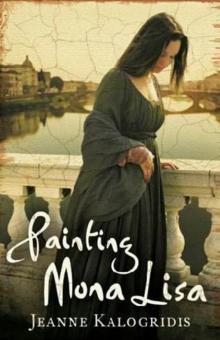 Painting Mona Lisa aka I, Mona Lisa
Painting Mona Lisa aka I, Mona Lisa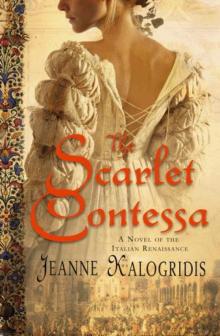 The Scarlet Contessa
The Scarlet Contessa I, Mona Lisa
I, Mona Lisa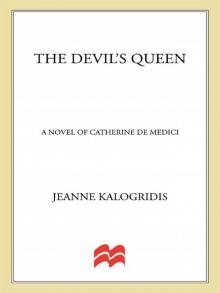 The Devil's Queen: A Novel of Catherine de Medici
The Devil's Queen: A Novel of Catherine de Medici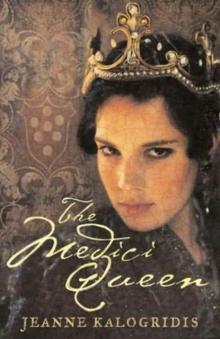 The Medici Queen aka The Devil’s Queen
The Medici Queen aka The Devil’s Queen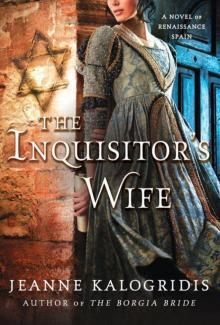 The Inquisitor's Wife
The Inquisitor's Wife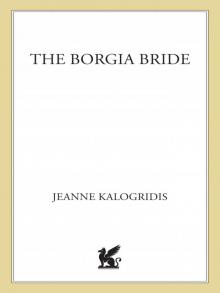 The Borgia Bride
The Borgia Bride